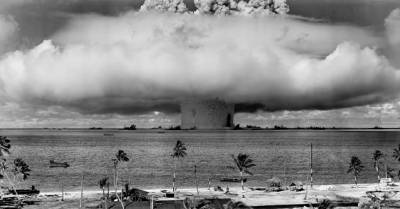Guest article by Patrick Bryant
Given the current level of international tensions, it seems germane to write the following guide for my fellow sailors. This is a dark topic, and any optimism I express about surviving the situation goes against conventional wisdom. I am in no way attempting to diminish the horror and severity, but only hope that this guide will be printed out and stowed away aboard somewhere where it will never, ever be needed.
I have taken a lifelong interest in radiological defense and survival. I was licensed long ago as a radiological monitor by the old Office of Civil Defense at the age of 13. I have studied the topic thoroughly in the intervening 50 years. I hold the patent (US patent 4,103.235) on the audio tone that is sent by US broadcast stations during Emergency Alert System tests and warnings. I am also a Coast Guard licensed master (near coastal).
This is intended to be a BRIEF description, in layman’s terms, of radiological defense and survival at sea. Much is left out of this narrative in the interest of brevity, and the reader is encouraged to study the topic in greater detail. If the time should ever arise that you have a critical need for this information, I presume you will want tactics that are succinct and contain a minimum of academic information. Armed with any information at all, you will be better prepared than the vast majority of Americans, who have received no instruction on the topic. I have read the prepared scripts that will be broadcast in the event of any attack, and the only information you will receive from official broadcasts is: “fallout is a byproduct of a nuclear explosion.” That’s all - nothing more. The vast majority of casualties will not be caused by the explosions but instead by the radioactive fallout that follows. Our government simply expects us to die, while they hide away in the hundred or so bunkers provided only for them.
Post-attack survival at sea presents unique challenges and may, depending on your location and local weather, present you with a survival advantage.
Your First Warning:
 Unless started by accident, a nuclear exchange is likely to be preceded by high levels of international tension. A limited exchange may precede a larger exchange by days or weeks. Perhaps this is why you will already be at sea. But your first warning that an exchange has occurred may be only the sudden loss of all of your electronics. Your GPS quits working, your radios go dead, your radar goes blank, and even if your HF radio continues to work, all you can receive is static (the HF band radio may recover after a few days). This will be due to an opening salvo of high altitude detonations producing an electromagnetic pulse (EMP) that fries transistorized electronics for over a thousand-mile radius. This is the early attack doctrine of Russia, and likely every other nuclear state. (The attack may, in fact, stop right here - having thrust the US into the 18th century.) Unless you have a sextant aboard, an accurate clock (a quartz clock may survive), a set of current tables, and the knowledge of how to take at least noon observations, you have a serious navigation problem. Depending on pilotage to sight objects on shore will put you dangerously close to the “action.” If you went to sea in anticipation of trouble, bring spare electronics and wrap them in aluminum foil (if you have a microwave oven, store them inside). There may be more than one wave of EMP attacks, so wait a few days after the attack to bring out your spares. GPS will probably never work again - ever. It’s a target. E-LORAN service, which the European and Asian countries are providing as a backup to GPS, may continue to function. But in US waters, you’ll have nothing but charts and a sextant.
Unless started by accident, a nuclear exchange is likely to be preceded by high levels of international tension. A limited exchange may precede a larger exchange by days or weeks. Perhaps this is why you will already be at sea. But your first warning that an exchange has occurred may be only the sudden loss of all of your electronics. Your GPS quits working, your radios go dead, your radar goes blank, and even if your HF radio continues to work, all you can receive is static (the HF band radio may recover after a few days). This will be due to an opening salvo of high altitude detonations producing an electromagnetic pulse (EMP) that fries transistorized electronics for over a thousand-mile radius. This is the early attack doctrine of Russia, and likely every other nuclear state. (The attack may, in fact, stop right here - having thrust the US into the 18th century.) Unless you have a sextant aboard, an accurate clock (a quartz clock may survive), a set of current tables, and the knowledge of how to take at least noon observations, you have a serious navigation problem. Depending on pilotage to sight objects on shore will put you dangerously close to the “action.” If you went to sea in anticipation of trouble, bring spare electronics and wrap them in aluminum foil (if you have a microwave oven, store them inside). There may be more than one wave of EMP attacks, so wait a few days after the attack to bring out your spares. GPS will probably never work again - ever. It’s a target. E-LORAN service, which the European and Asian countries are providing as a backup to GPS, may continue to function. But in US waters, you’ll have nothing but charts and a sextant.
Survivability:
You CAN survive the fallout if you take appropriate steps. The likelihood of an all-out exchange is smaller than popularly supposed. Although a conflict with nuclear weapons is insane beyond words, national leaders are not suicidal, and once a conflict breaks out, their goal will be to win with minimal losses. Yes, “win”, as insane as that sounds. So their goal will be to stop the conflict at some stage of appeasement.
Life after a nuclear exchange will present the survivors with one of the greatest challenges in the history of our species. We may face what is known as a “population bottleneck.” But it won’t be the first in history. The pre-1492 native population of the Americas are the descendants of only 70 individuals who crossed the land bridge between Asia and North America. The Toba eruption catastrophe, which occurred about 75,000 years ago, caused a global volcanic winter of 6-10 years and possibly a 1,000-year-long cooling episode. It reduced the human population to somewhere between 2,000 and 20,000 individuals. A post-nuclear world will be awful, and the lingering effects of radiation will be an existential challenge to all forms of life. But survival will not be impossible. There won’t be any smartphones or Starbucks, but don’t just give up.
What is radiation?
Any energy that radiates is radiation. Sound and light radiate. What we are concerned with here is ionizing radiation -- radiation that has the capacity to ionize the elements in your body to cause harm to your tissues. Ionizing radiation is divided into three classes: Alpha, Beta, and Gamma (the first three letters of the Greek alphabet).
Alpha radiation is made up of particles. The particles are so large that they can’t pass through a sheet of paper. The outer layer of dead skin on your body is adequate protection. However, if you inhale or ingest alpha particles, they will do severe damage to you internally.
Beta radiation is made up of sub-atomic particles: high-speed electrons or positrons emitted from the radioactive decay of an atomic nucleus. They are very small and can penetrate through your skin, causing burns that look like ordinary thermal burns. They are also very harmful if inhaled or ingested.
Gamma radiation is photons, like light, but at a much shorter wavelength and with enough penetrating power that your entire body will barely block them. Gamma shines right through you. Gamma is more penetrating than medical X-rays and it takes several inches of lead to shield gamma to half its intensity.
Radiation from the Detonation:
The detonation produces a vast amount of X-rays and some gamma radiation. The X-ray radiation is absorbed by the air, which causes it to be heated sufficiently to ignite the air. This forms the characteristic fireball of a nuclear explosion (only a small fraction of the thermal energy is released by the bomb itself). If you are close enough to receive a dangerous dose of this “initial radiation,” you will be dead in the next few milliseconds from the heat and blast. Consequently, radiological defense ignores the effects of initial radiation.
Fallout
Fallout is produced by a nuclear weapon exploding and excavating thousands of tons of earth into the air. The metals in the earth (iron, calcium, etc.) have their atoms stripped of their subatomic particles by the detonation, turning those metals into isotopes - energized elements that must then radiate ionizing radiation in order to return to a neutral state. Most of the bomb itself isn’t converted into energy (only a tiny fraction), and this radioactive bomb residue is also mixed in with the vaporized earth. Depending on the target, the bomb may detonate near the surface, or in the air. Surface detonations are used to destroy hardened targets like missile silos; air bursts are used to maximize the bomb effects to destroy soft targets - like cities. Air bursts excavate less earth, and produce less fallout.
Fallout begins to reach the surface about 20 to 30 minutes after a detonation. It takes time for the vaporized earth to cool and condense into a solid. Fallout appears like sand or small pellets, or like grey-colored snow. If it comes down in rain, it is technically called “rainout”. The detonation produces its own “wind” and will carry some of the fallout upwind of the prevailing wind. The rest will be carried downwind. Together, these two effects produce a pattern on the surface that resembles a “keyhole,” with the round part of the keyhole centered at the point of detonation. Fallout can be carried hundreds of miles downwind, though the most dangerous fallout will be concentrated near the point of detonation.
Protection from Fallout:
How much radiation is safe? The absolute answer is: “none of it is safe.” But you can say the same about sunlight, since it causes skin cancer. That doesn’t stop you from going out in the sunlight. Just as you mitigate the risks of moderate exposure to sunlight with sunscreen and clothing, you can mitigate the risk of ionizing radiation with protective strategies.
There are three elements to providing protection from ionizing radiation: Distance, Shielding, and Time.
Distance: radiation decreases with distance from its source according to “square law.” Double the distance, and the intensity is decreased by a factor of four.
Shielding: In a vessel, the deck will offer very good shielding from alpha and beta radiation. Gamma will pass right through the thin deck materials of small vessels. Still, the overall protection of the deck will cause about one half (a “protection factor” of two) of the mix of alpha, beta, and gamma to pass through to the cabin. Shielding your deck is not a good strategy on a small boat. However, fallout is heavier than water, it will sink, and water is a good shield. In turbulent water, fallout that lands on the water will sink below the surface.
Time: The overall mix of radioactive isotopes has a half-life of about 45 minutes. That is, it decays to one half intensity every 45 minutes. This rule of thumb only applies to ordinary earth being excavated by the bomb. If the adversary is truly desperate, they may detonate bombs over atomic power plants, thus excavating the entire contents of those plants, which contain massive amounts of materials with much longer half-lives. Or, they may sheath their bombs in cobalt, the isotope of which has an enormously long half-life. Hopefully, the situation won’t reach that level of desperation, and the adversary also denies access to themselves of any area contaminated by long-lived fallout.
Time and distance are your friends aboard a boat. You also have available a defensive strategy that is unique to your environment: you can physically remove the fallout by washing it off the deck. The Navy has installed aboard on some vessels what they call “automatic washdown systems.” Basically, sprinklers to washdown the deck. You will have to use a bucket. Wash down the weather deck frequently. Wash yourself down before you return to the cabin, paying special attention to your hair and folds of skin (under arms, behind ears, etc.) where fallout can collect. Keep in mind that if you are far from a detonation, the fallout that reaches you has been decaying the entire time it took to reach you. Early after a detonation, you can see the smoke. Stay out of it! Air is actually a shield, provided there is miles of it between you and the fallout. The 30 miles of air above you right now has the equivalent density of 15 feet of concrete.
Staying offshore and in areas where coastal winds have an onshore flow (wind that blows from a body of water towards the land) will keep the fallout away from your vessel. Fallout that arrives from far away will have decayed before it arrives.
Detecting Radiation
Unless you have radiological survey instruments aboard, you have no way of detecting radiation. None of your senses will detect it, although a few persons who died soon after exposure at the Chernobyl disaster reported a metallic smell and taste in the air (probably ozone). If there’s enough radiation to be detected in this way, your existence is extremely limited. Hours at most. I won’t go into the subject of radiological dosimetry here because it’s unlikely you will have the instruments to use the information. If you acquire the instruments, read up on the topic.
The Health Effects of Ionizing Radiation
Ionizing radiation causes two classes of adverse health effects, short term and long term. The short term effects are caused by radiation interfering with cell division. Your cells are constantly dividing, and some types of cells divide more frequently than others. The cells in your gastrointestinal tract and the cells of your immune system are the most sensitive. Bone and nerve cells are the least sensitive. The first symptoms to appear are like stomach flu: nausea and diarrhea. These symptoms can be severe enough that you can die from dehydration. Some experts have suggested using vomiting as a symptom for identifying radiation sickness. However, there are many causes besides radiation sickness that can produce vomiting (seasickness, for example). If a person has not vomited, this is a good sign, but vomiting alone is not an accurate “bio-dosimeter.” The next effect to occur after nausea is a dramatic decline in resistance to infection. Your white count plummets. The primary cause of prompt death and morbidity from acute radiation poisoning is infection. This makes hygiene and sterile wound treatment of primary importance. Antibiotics work with your immune system, and may be of very limited effectiveness after radiation poisoning. Use them if you have them, but they may not work. A person that has received a lethal dose of radiation may temporarily recover and experience a few weeks of remission before dying of an opportunistic infection. Those who survive a sub-lethal dose may experience hair loss and sterility, both of which are usually temporary. Pregnant women, whose fetus is undergoing rapid cell divisions, may spontaneously abort.
Radiation sickness is not contagious - no more so than a sunburn is contagious. Someone who is acutely ill from an infection however may be contagious. Discerning the difference may be very difficult.
Treatment of acute radiation sickness is entirely symptomatic. Treat dehydration with water and electrolytes. Treat infection with rest. Taking a supplement of potassium iodide will flood the body with iodine and help prevent thyroid cancer from radioactive iodine. Radioactive iodine has a rather short half-life, so this precaution becomes less important weeks or months after an attack. If you have multivitamins aboard that contain iodine, taking a daily dose may help.
The long-term health effects center around the mutagenic effects: radiation scrambling your DNA. There will be an increased risk of cancer, but to put that in perspective, if you survive the short-term effects, your risk of cancer will be about the same as smoking cigarettes for a decade or two. How many people do you know who have done that and survived to old age? The worst long term effects will be contamination to the food chain. Isotopes of strontium and cesium are fairly long-lived (decades) and enter the food chain as calcium. Children are especially susceptible to strontium and cesium contaminated food. Taking calcium supplements would be prudent for children (adults don’t absorb much dietary calcium). Food in cans or other sealed containers is safe to eat. Eating other foods will probably be a better alternative than outright starvation.
Coming Ashore
You’re going to be confronted by an epic mess ashore. While offshore, you are unlikely to be considered a threat by any military - they’ll have bigger fish to fry. But as you approach the shore within the range of small power boats, you may face the risk of piracy. Anyone who remained ashore in affected areas and failed to practice radiological defense will be too weak to be a threat. You may be the only healthy person around once you reach shore. I am at a loss to give you any advice here except to do your best to survive a likely breakdown of all civil authority. You may be the best person around who possess the health to cope with the challenges.
Those of us who sail are uniquely qualified by skills and temperament to face the challenges of survival without the conveniences of modernity. Plus, we will have one of the few vehicles that can still travel long distances without petroleum.
Good luck.
Patrick Bryant
May 5, 2017
Mountain View, California




